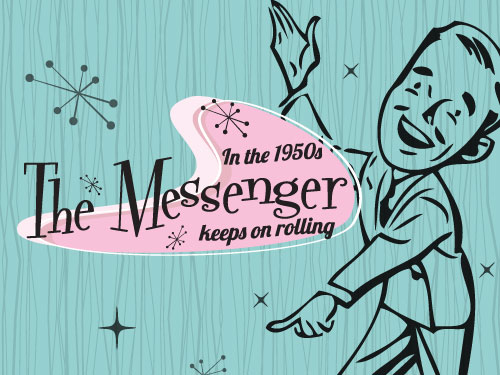By 1950, Baptist Messenger subscriptions had passed the 50,000 mark, and a new, young editor, Jack Gritz, 32, was at the helm, and would begin three decades of service to Oklahoma Baptists’ news journal.
The Messenger offered three subscription plans—the church budget plan, the club plan and individual subscriptions. Five hundred, seventy-nine churches used the church budget plan, sending the Messenger to their members’ homes for 10 cents per subscription, per month. The club plan provided four Messengers for $5 to the same post office for one year. Individuals could subscribe for $2 for one year and $3.50 for two years. Fifteen churches were using the pages of the Messenger for their news.
Gritz often joked that the Messenger was worth the 10 cents per issue subscription cost, but it was worth 25 cents for what was left out.
The “Every Baptist Family in Oklahoma Reading the Baptist Messenger Through the Church Budget Plan” campaign stated that the paper does not cost—it pays in the form of an informed, invigorated, world-visioned membership continuously reminded of their duty to the local church and all Kingdom causes.”
The Messenger had four full-time employees in the editorial office—the editor; Fern Hurt, editorial assistant; Sam V. Brents, assistant editor and Mrs. Bill Williams, secretary. Bill Cox ran the addressograph machine, stamping out the 50,000 names and addresses on long mailing tapes. Press superintendent was Clifford Smith, and those doing make-up, composition and press operations were Merle Lee, David Truby, Eugene Nance, Clarence Stratton, T.A. Davis, Glenn Dooley, Russell Click, Herbert Merkle, Joe Morgan, James Foster and Bill Burton.
The entire printing process was still done in Shawnee at the OBU press, capable of producing 1,500 pages in an hour.
In 1950, the editorial offices were moved to a new $450,000, 30,000-square-foot, four-story, fireproof building at 1141 N. Robinson, which housed all offices of the Baptist General Convention of Oklahoma.
By 1956, the Messenger had 18 employees, seven full-time and four part-time in the press room; five full-time and two part-time in the editorial office. In 1957, Leland Webb succeeded Brents as assistant editor.
Value of the press and equipment was $84,702, and the operating budget was $15,000, with $22,000 from the Cooperative Program, $90,000 from subscriptions, $20,000 from special church editions and $12,000 from advertising and other sources. Circulation of the paper exceeded 76,000.
In his report to the state convention in 1955, Editor Gritz said the Messenger costs 10 cents.
“But,” he added, “How much does it cost not to send the Messenger? How much does it cost in church members who are indifferent, unenlisted and uninformed? How much does it cost in the fires of missionary enthusiasm turned into the cold ashes of sinful selfishness? How much does it cost in lost evangelistic zeal which leaves souls doomed and damned? How can we measure the cost?”
In 1954, the Messenger moved its press operations from Shawnee to a vacant storeroom in the basement of the Baptist Building. The new machinery, including new Linotype, glider saw, miterer, proof press, stone handset type and casting box, was valued at $75,000. The Miller Major SY 41 printing press was capable of 4,250 impressions per hour.
The look of the Messenger remained much the same throughout the 1950s, with the front cover almost always a full-page photograph.
The attendance report continued to list the churches with the top numbers, with Tulsa, First leading the way almost every week. By 1956, churches reporting attendance were alphabetized.
The Messenger has always published 50 issues a year, with no editions one week in the summer and the last week in December. Beginning in 1955, during a week in August, the Messenger presented a special issue, usually on what Baptists believe.
Much of the space in 1959 was devoted to the issue of making the sale of liquor legal in Oklahoma. Out of the 50 issues that year, 38 contained a story or editorial on the subject.





